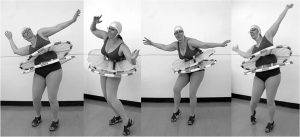Source : Robert Jacobs, Mark Feldmeier, Joseph A. Paradiso. 2007. A Mobile Music Environment Using a PD Compiler and Wireless Sensors. Responsive Environments Group MIT Media Lab 20 Ames St., Cambridge MA 02139, USA
Summary : The article „A Mobile Music Environment Using a PD Compiler and Wireless Sensors“ introduces a new technology, to modify music portable, without heavy equipment. They work with a Nokia N800 and use the Zigbee Protocoll, and their Pure Data Compiler, which reads text, parses it with Perl and uses C. They want to combine the usability of Pure Data with the efficiency of C, furthermore they improve the debugging. They communicate via a serial input and output with the Nokia and attach sensors to low power microcontrollers. They are aiming for a commercial setting. People could use their software and hardware configuration while jogging. The speed of the music could encourage people to run faster or slower or it simply tries to synchronise with the runner. Main points are portability(low weight, small size), even though fast and direct interaction, low costs and multiple hours of battery.
Relevance for our project : Due to the fact, that we work in a very special environment(theater/stage performance), we can only adapt parts of the article to our work. In our case, there won’t be a mobile phone with the actor or dancer. But we also have to consider wisely which hardware and software we use, to provide fast communication between sensor, arduino and stage-computer. To keep interference between actor and costume as small as possible, we defnitely need, low weight, small size and probably more or less invisible wearables or e-textiles.

